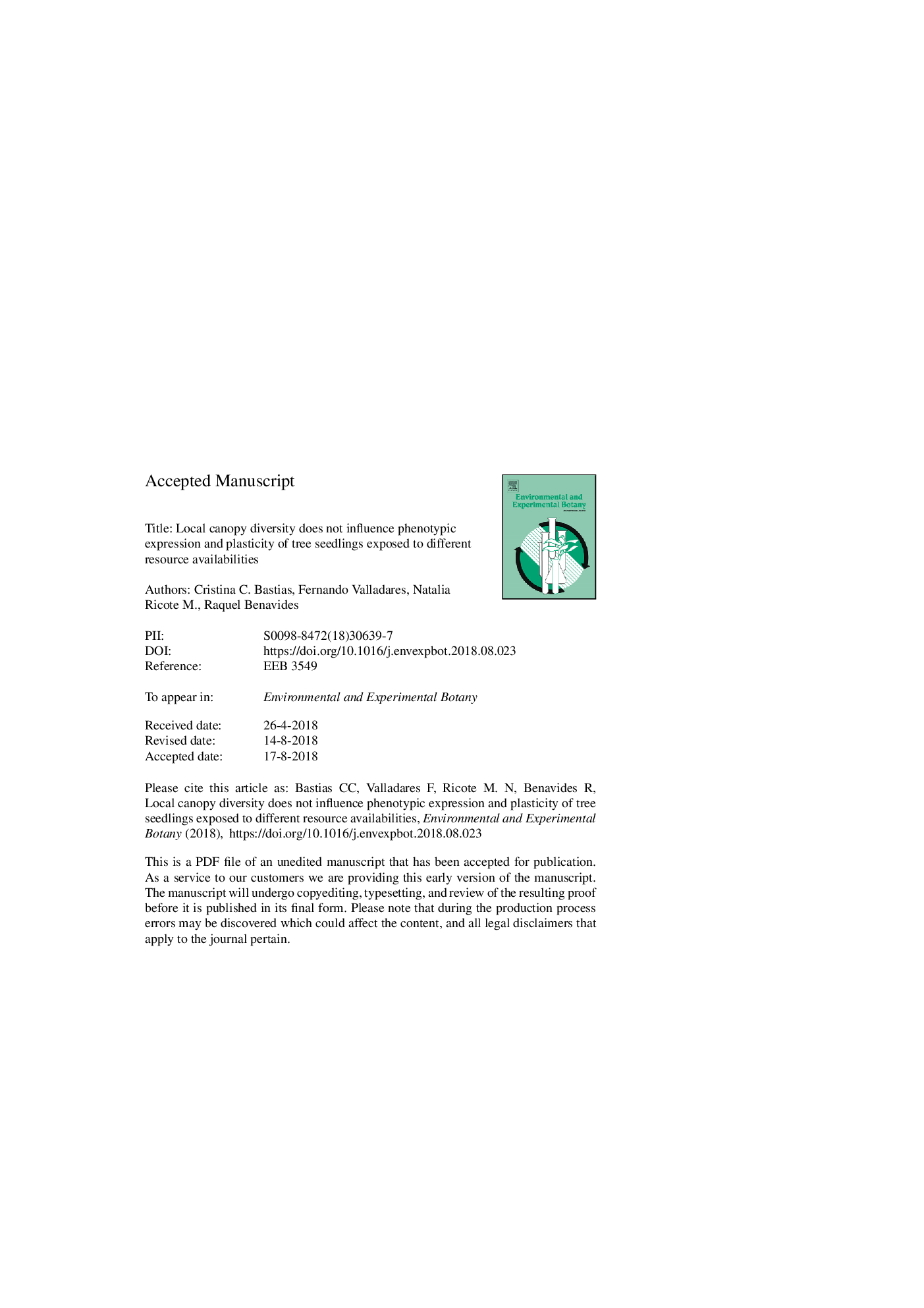| کد مقاله | کد نشریه | سال انتشار | مقاله انگلیسی | نسخه تمام متن |
|---|---|---|---|---|
| 8959438 | 1646317 | 2018 | 34 صفحه PDF | دانلود رایگان |
عنوان انگلیسی مقاله ISI
Local canopy diversity does not influence phenotypic expression and plasticity of tree seedlings exposed to different resource availabilities
ترجمه فارسی عنوان
تنوع محلی تاج پوشش تاثیرات فنوتیپیک و پلاستیسیته نهال های درختی را تحت تاثیر قرار نمی دهد
دانلود مقاله + سفارش ترجمه
دانلود مقاله ISI انگلیسی
رایگان برای ایرانیان
کلمات کلیدی
غنای گونه، درمان نور درمان تغذیه ای تنوع صفات، گروه های عاملی، پلاستیک فنتیکی
ترجمه چکیده
به نظر می رسد تنوع گونه ها به ناهمگونی محیط زیست و پیچیدگی زیستگاه منجر شده است، که به نوبه خود بر انتخاب سطوح بالاتری از ظرافت فنوتیپی گونه های گیاهی تأثیر می گذارد. در حالی که شواهد اخیر نشان داد که تنوع گونه های محلی و ناهمگنی زیست محیطی به عنوان فشار انتخابی بر روی صفات و پلاستیسیته گیاهان تاثیر می گذارند که ویژگی های آنها را به هویت و غنای گونه های همسایگان خود تنظیم می کند، برای گونه های درختی کمی شناخته شده است. در اینجا ما تغییرات در بیان و پلاستیک فنوتیپی و گیاهچه های دو گروه کاربردی (گسترده و درختان) که از جوامع با غنای گونه های مختلف قاجاری در دو نوع مخروط جنگل (جنگل های همجوار و مدیترانه ای) می آیند، مورد بررسی قرار دادیم. ما یک آزمایش گلخانه ای را انجام دادیم تا واکنش نهال ها را در دسترس بودن نور و مواد مغذی مختلف، اندازه گیری صفات کاربردی مختلف مربوط به کسب منابع را بررسی کنیم. نتایج ما نشان داد که نهال هایی که از جوامع تک تک و متنوع متنوع تر بودند، توانایی بیان و پاسخ فنوتیپی مشابهی را به درمان های مطالعه داشتند. این یافته ها نشان می دهد که غنای گونه کانوپی در این مرحله زودرس فشارهای انتخابی قابل تشخیص را بر روی فنوتیپ های درختی و پلاستیک نداشته است. علاوه بر این، تفاوت های بزرگی در بیان و پویایی فنوتیپ بین دو گروه عمده عملکردی (گونه های مخروطی و گونه گسترده ای) یافت شد. به طور مشخص، ما دریافتیم که لایه های سفید به وسیله ی پلاستیک های سبک و مواد مغذی نسبت به گونه های مخروطی، عمدتا در جنگل های مدیترانه، به مقادیر متوسط بالاتر در صفات عملکردی اصلی رسید. این یافته نشان می دهد که گونه های گسترده ای بالقوه ظرفیت بالاتری برای پاسخگویی به شرایط محیطی آینده در مقایسه با گونه های کپور در مراحل اولیه دارند، که مزیتی است که می تواند برای توان رقابتی گونه ها برای منابع و به همین دلیل برای بقاء حیاتی باشد.
موضوعات مرتبط
علوم زیستی و بیوفناوری
علوم کشاورزی و بیولوژیک
بوم شناسی، تکامل، رفتار و سامانه شناسی
چکیده انگلیسی
Species diversity seems to favour the environmental heterogeneity and habitat complexity, which in turn favour the selection of greater levels of phenotypic plasticity of plant species. While recent evidence suggested that local species diversity and environmental heterogeneity act as selective pressures over mean traits and plasticity for herbs, which adjust their traits to the identity and species richness of their neighbors, little is known for tree species. Here, we investigated shifts in the phenotypic expression and plasticity of seedlings of two functional groups (broadleaved and conifers) coming from communities with different canopy species richness in two contrasting forest types (a hemiboreal and a Mediterranean forest). We carried out a greenhouse experiment to test the response of seedlings to different light and nutrient availability, measuring different functional traits related to resource acquisition. Our results indicated that seedlings coming from monospecific and more diverse communities had similar phenotypic expression and response capacity to the study treatments. This finding suggests that canopy species richness did not exert a detectable selective pressure on tree phenotypes and plasticity at this early stage. Additionally, we found great differences in the phenotypic expression and plasticity between the two major functional groups (conifers and broadleaved species). Specifically, we found that broadleaves reached higher mean values in key functional traits by a greater plasticity to both light and nutrient treatment than coniferous species, mainly in the Mediterranean forest. This finding suggests that broadleaved species potentially have a higher capacity to respond to future changing environmental conditions than conifers at early stages, conferring an advantage that can be crucial for the species competitive ability for resources and, therefore, for survival.
ناشر
Database: Elsevier - ScienceDirect (ساینس دایرکت)
Journal: Environmental and Experimental Botany - Volume 156, December 2018, Pages 38-47
Journal: Environmental and Experimental Botany - Volume 156, December 2018, Pages 38-47
نویسندگان
Cristina C. Bastias, Fernando Valladares, Natalia Ricote M., Raquel Benavides,
